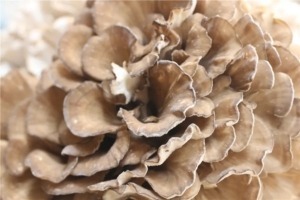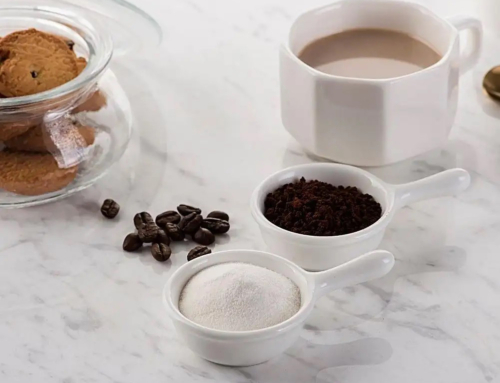- Polysaccharides
In the past 30 years, over 47 bioactive polysaccharide fractions have been isolated and purified from the fruiting body, mycelium, and cultured medium of G. frondosa using different extraction methods. G. frondosa contains 3.8% water-soluble polysaccharides on a dry weight basis, of which 13.2% was (1→3, 1→6)-β-D-glucan, and others include heteroglycan or the heteroglycan/protein complex. Among these bioactive polysaccharide fractions, the D-fraction and the MD-fraction (purified D-fraction), the most important bioactive polysaccharides, have been officially used as antitumor, anticancer, and immunomodulatory agents. Through structural characterization, scientists discovered the complex structure of the β-D-glucan in the D-fraction.
Unlike other mushroom-derived β-glucans that contained a (1→3) main chain with (1→6) branches only, the β-D-glucan in D-fraction possessed both a (1→6) main chain with (1→3) branches and a (1→3) main chain with (1→6) branches. The high molecular weight of the D-fraction was considered a factor contributing to its solid immunomodulatory effects. The D-fraction and the MD-fraction could be extracted and fractionated from the mycelium and fruiting body of G. frondosa. The MD fraction is typically extracted from the dried G. frondosa powder with boiling water and then isolated by ethanol precipitation. The residue (crude MD fraction) is further fractionated through column chromatography, including ion exchange and gel permeation chromatography, to obtain the purified MD fraction.
 Apart from the D-fraction and the MD-fraction, other polysaccharide fractions have also been derived from G. frondosa, with hot water being the most commonly used extraction solvent. Ultrasound and other solvents such as hot sodium hydroxide and citrate buffer have also been utilized. The chemical properties of representative bioactive polysaccharide fractions isolated from G. frondosa include molecular weight, structure information, and monosaccharide compositions. For instance, the X-fraction from the fruiting body of G. frondose is a (1→6)-β-glucan with (1→4)-α branches. The X-fraction showed anti-diabetic activity, which was directly associated with insulin receptors. The MZ-fraction is separated from G. frondosa, which had a similar structure to the MD-fraction but with a much smaller molecular weight of around 20,000 Da (the molecular weight of MD-fraction was about 1–2 million Da). The MZ-fraction showed immunomodulatory effects in vitro and antitumor activity in vivo.
Apart from the D-fraction and the MD-fraction, other polysaccharide fractions have also been derived from G. frondosa, with hot water being the most commonly used extraction solvent. Ultrasound and other solvents such as hot sodium hydroxide and citrate buffer have also been utilized. The chemical properties of representative bioactive polysaccharide fractions isolated from G. frondosa include molecular weight, structure information, and monosaccharide compositions. For instance, the X-fraction from the fruiting body of G. frondose is a (1→6)-β-glucan with (1→4)-α branches. The X-fraction showed anti-diabetic activity, which was directly associated with insulin receptors. The MZ-fraction is separated from G. frondosa, which had a similar structure to the MD-fraction but with a much smaller molecular weight of around 20,000 Da (the molecular weight of MD-fraction was about 1–2 million Da). The MZ-fraction showed immunomodulatory effects in vitro and antitumor activity in vivo.
Moreover, Grifolan (GRN), a gel-forming (1→6)-branched (1→3)-β-D-glucan, was found in G. frondosa with immunomodulatory effects. α-D-glucan could also be extracted by hot water from G. frondosa. Instead of antitumor activity, hypoglycemic, hypolipidemic, antioxidative, and immunomodulatory effects were discovered. In recent years, Scientists in China have isolated various polysaccharides from G. frondosa with GFP-A, LMw-GFP, and GFAP, all exhibiting promising antitumor activities. Due to external factors such as the fungal source and extraction temperature, the properties of polysaccharide fractions from different sources may vary significantly.
- Proteins and Peptides
Several bioactive proteins and peptides have been isolated from G. frondosa with notable health benefits and medicinal values. However, studies on these aspects are fewer than those on the bioactive polysaccharide fractions. These bioactive proteins/peptides were extracted mainly from the G. frondosa fruiting body, with average molecular weights around 20–88 kDa.The N-acetylgalactosamine-specific lectin GFL isolated from the G. frondosa fruiting body exhibited cytotoxicity against HeLa cells. The protein-designated GFAHP showed a significant anti-herpes simplex virus (HSV) effect. Glycoprotein is another type of bioactive protein in G. frondosa. Scientists isolated the glycoprotein (containing 6.2% carbohydrates) from cultured mycelia of G. frondosa and demonstrated its antitumor activity. A bioactive glycoprotein from G. frondose showed obvious anti-hypertensive, anti-obesity, anti-hyperlipidemic, and anti-diabetic effects.
In addition to the glycoprotein, chemical phosphorylation of G. frondosa polysaccharide-peptides could remarkably enhance both tumor inhibition in vitro and adjuvant effects in vivo. Meanwhile, modified and unmodified MPSP showed an insignificant impact on normal cells, indicating their potential application for anticancer therapy without significant side effects.
- Other Bioactive Molecules
Apart from the macromolecular components, such as polysaccharides and proteins/peptides, small bioactive molecules have also been discovered in G. frondosa. The major small molecules discovered with bioactivities mainly include fatty acids, ergosterols, flavonoids, alkaloids, ascorbic acid, and tocopherol.
Fatty acids and three compounds, ergosterol, ergostra-4,6,8, 22-tetraen-3-one, and 1-oleoyl-2-linoleoyl-3-palmitoylglycerol, were extracted from the cultured mycelia of G. frondosa by hexane. The fatty acid fraction and all three compounds exhibited cyclooxygenase (COX) enzyme inhibitory and antioxidant activities. Researchers extracted a furanone named grifolaone A from G. frondosa, showing specific antifungal activity against the opportunistic human pathogen Pseudallescheria boydii and some plant pathogens. They also isolated agaricoglycerides (AGF) from the fermented mycelium of G. frondosa. Their study suggested a promising possibility of using AGF as medicine for inflammatory pain, with 500 mg/kg as the optimal dosage.
Three fractions, GF-1 to GF-3, from G. frondosa showed the inhibitory effect of GF-3 against the proliferation of human tumor cells and α-glucosidase. The major bioactive compounds in GF-3 were alkaloids (first found in G. frondosa), ergosterols, and a new compound named pyrrolefronine. Since α-glucosidase was involved in the hydrolysis of starch into disaccharide sugars, inhibition of its activity indicated a possible reduction in blood glucose level. o-orsellinaldehyde, which showed apparent tumoricidal activity, especially selective cytotoxic effect against Hep 3B cells through apoptosis, was also extracted from the submerged culture of G. frondosa. In addition, other bioactive molecules in G. frondosa, such as polyphenolics, α-tocopherol, ascorbic acid, and flavonoids, were reported to have antioxidant properties.


Leave A Comment